Catalina Flying Boats at Foynes
Three unexpected landings at Foynes Flying Boat base during The
Emergency.
The flying boat base at Foynes on the Shannon River Estuary had been developed before the war as a crucial hub of the then fledgling Trans-Atlantic flying business. The technology of 1930's aviation meant that the most efficient equipment at that time to cross the Atlantic were the large flying boats. This business was just beginning to blossom when the war interrupted events. It was for this very reason that operations however continued through the base as the United Kingdom and later the United States used Foynes as a hub for their civilian airline operations, with flights arriving from the United States and Portugal on a regular basis. The aircraft as one might imagine did not carry holidaying passengers but for the most part people flying on war related tasks. It was into the base at Foynes that doomed BOAC Sunderland G-AGES was bound on the night of July 27th, 1943. Her flight ended in tragedy on Mount Brandon in Kerry. The story of that crash can be read at this link on the site.
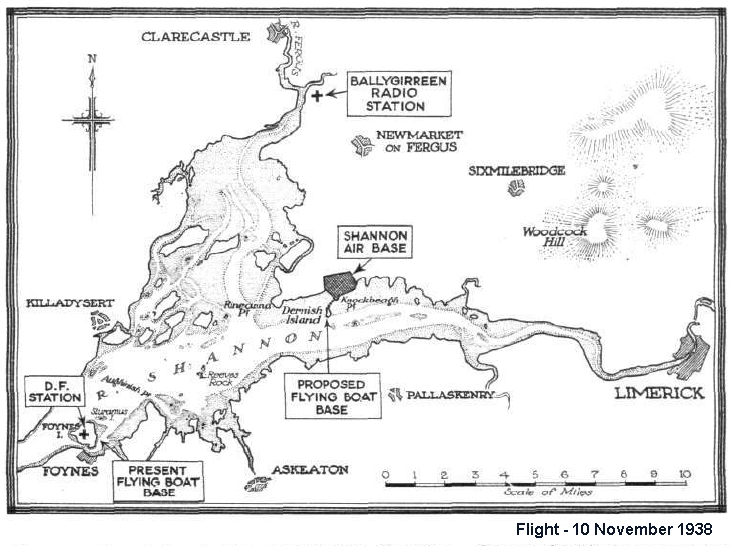
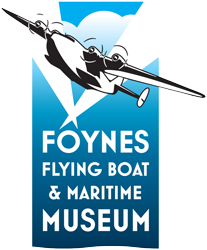 The above map
comes from a 1938 article in the British magazine Flight
discussing the facilities being built at that time across the
Shannon estuary. The former base at Foynes is now a museum
and their website contains a wealth of information about its
extensive wartime activities. A visit to the museum, which is
only a few minutes outside Limerick City is well worth while. To
visit their website, simply click on the logo for the museum to
the left of this text.
The above map
comes from a 1938 article in the British magazine Flight
discussing the facilities being built at that time across the
Shannon estuary. The former base at Foynes is now a museum
and their website contains a wealth of information about its
extensive wartime activities. A visit to the museum, which is
only a few minutes outside Limerick City is well worth while. To
visit their website, simply click on the logo for the museum to
the left of this text.
This page on my site however details three unplanned wartime landings at or near Foynes by military flying boats who had experienced difficulties. All three were Catalina flying boats, one flying with an RAF training unit based at Lough Erne in Northern Ireland and two more aircraft on their delivery ferry flights from North America. The short stories of Catalina's FP202, JX330 and JX422 are told below.
Consolidated Catalina, FP202, 1942
On the 19th of November 1942, a Catalina flying from the RAF base at Lough Erne in Fermanagh was forced to make an emergency landing on the Shannon Estuary. Notification was made to the base personnel at Foynes and a vessel was sent to tow the aircraft into the flying boats slipways. The combination made it to the base after a tow lasting two hours. The crew reported that they had experienced radio trouble and an engine fault. They also said they had bumped the aircraft upon landing on shallow mud flats. The landing was recorded as having taken place at 00:40 on the 19th. The crew disembarked from the aircraft for a few hours but following some rest, they departed Foynes at 13:45.
The the names and details of the crew of Catalina FP202 were
recorded in rather poor hand writing in the Irish Army report
but luckily all bar one of the men had their service numbers
recorded. With this information it was possible to confirm their
names. As they had been posted to a Ferry Training Unit,
it was assumed that they were in the process of being prepared
for service outside of the United Kingdom. Sgt Mark Mehr's
name, as mentioned below, was recorded in Canadian newspapers a
few weeks prior as being based with a newly formed Canadian unit
in the UK.
By searching the Operations Record Books for some of the
overseas Catalina units for the early 1943 period, all the crew
members were found to have been posted to 270 Squadron based in
West Africa. The Squadron were posted there in December
1942 and flew operations from Jui in Sierra Leone among other
places.
They flew Catalina patrols for the most part of Feb 1943
through to the new year of 1944. An early non operational
mission some of the men flew was a flight to Abidjan, in French
Ivory Coast, which had lately come under Allied influence
following the North African landings. This was a
reconnaissance mission to determine the facilities available for
future flying boat operations and to determine the minds of the
population towards the United Nations and the British. The
crew were billeted at various hotels and French army camps and
according to a report in the squadron ORB, had a pleasant few
days at the town.
The Form 540 summaries are largely just patrol summaries for
most of 1943, with almost no mention of officer postings, some
promotions and are devoid completely of airmen's serial numbers.
An exception is a listing of personnel in May 1943 who had been
awarded the distinction of wearing the 1939-43 Star
Ribbon. In that C G Moore and W Bitz are listed.
Bitz and Carter are evident on one patrol in March 1944, but by
that time the ORB was being partially hand written in a most
unreadable fashion.
What can be determined about the men is presented below.
F/Lt Cecil George MOORE 68796. This officer
appears to have been active with 270 Squadron well into 1944,
flying Catalina missions even after the unit was transitioning
to Sunderlands. His name appears in the London Gazette in
the summer of 1941 within a list of consecutively commissioned
officers. His name does not appear to show up in the
London Gazette after August 1943.
Nothing else much has been determined about this officer other
than his 270 Squadron service.
P/O John Douglas HENDERSON 132077 - This officers
serial number was not recorded by the Irish authorities however
review of the London Gazette along with the sparse details in
the 270 Squadron ORB links him to the serial number through
mentions of a promotion in August 1943 and the award of a
service medal in 1944. Little else however is known about
him.
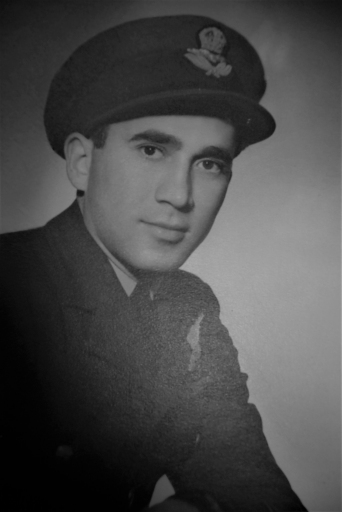 F/Sgt Mark MEHR
R/83970 RCAF came from Toronto, Ontario based on the listing of
a navigator named Sgt. Mark Mehr in August 1942 Canadian
newspaper articles reporting on the formation of a new Squadron
in the UK with Catalina flying boats. This is thought to
have been 422 Squadron but the available Squadron records don't
highlight Sgt Mehr's name.
F/Sgt Mark MEHR
R/83970 RCAF came from Toronto, Ontario based on the listing of
a navigator named Sgt. Mark Mehr in August 1942 Canadian
newspaper articles reporting on the formation of a new Squadron
in the UK with Catalina flying boats. This is thought to
have been 422 Squadron but the available Squadron records don't
highlight Sgt Mehr's name.
It is thought he was the son of Hyman and Sarah Mehr and was
born in Toronto in 1915, passing away in Florida in June 1999.
Following their arrival in Africa with 270 Squadron, Mark is
found to fly with a large number of crew Captains during 1942,
and not just Moore/Henderson.
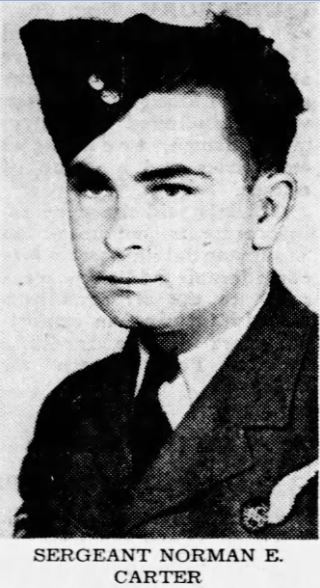 F/Sgt
Norman Edward CARTER R/83378 RCAF
F/Sgt
Norman Edward CARTER R/83378 RCAF
Sgt Carter's service details were provided kindly by H
Halliday. Born in 1918 in Windsor, Ontarior, Norman was
the son of Albert and Theresa Carter. Norman graduated
from 3 Bombing and Gunnery School in October 1941 with
newspapers publishing that he was from Windsor, Ontario.
His local paper the Windsor Star published a photo of him along
with news of his graduation in October 1941.
SERGEANT NORMAN E. CARTER Son of Mr.
and Mrs. A. E. Carter, 1171 Lillian street, who has received
his wings as a wireless air gunner with the Royal Canadian
Air Force. Sergeant Carter trained at MacDonald, Man., and
is now home on leave.
They carried a number of reports about his wartime exploits,
particularly in 1944.
In February 1944 they reported: SGT.
NORMAN "NICK" CARTER, 25-year-old wireless air gunner of
Windsor, Ont., attached to a squadron in West Africa, pauses
in his work to sniff the perfume of a flowering tropical
vine. Joining the R.C.A.F. in February, 1941, he has flown
operationally on coastal command work from England and has
helped to attack a submarine. He has been in West Africa
over nine months. This picture was taken by PO. Jack
Dalsleish. former Windsor Star photographer who made a tour
of R.A.F. units in Africa.
In October 1944 they reported on his being commissioned as an
officer, followed in December by the happy news of his marriage
in England with the interesting note on the presence of D V
Sweeting as best man:
Officer Is Married in England: A wedding of wide interest was solemnized
recently at St. John's Church, Southend. Catford. London.
England, when Miss Joyce Eastland. elder daughter of Mr. and
Mrs. A. F. Eastland of Conisboro Crescent. Catford, was
united in marriage to PO. Norman E. Carter. R.C.A.F., eldest
son of Mr. and Mrs. A. E. Carter of Lillian street, the Rev.
C. E. Youngman officiating. Given in marriage by her father,
the bride was gowned in frosty white crepe, featuring a
square neckline, and wore a gold locket. Her veil, which
extended into a tram, was held with orange blossoms and she
carried shower bouquet of pink carnations. Miss Pamela
Eastland, as her sister's only attendant, wore a flowered
print gown of turquoise blue, styled with a high neckline,
and a Peter Pan collar. She carried a bouquet of mixed
asters. FO. D. V. Sweeting, R.A.F., assisted as best
man. A reception followed at Pyne's Restaurant, near
Lewisham. when the best man proposed a toast to the
bridegroom and his friends in Canada. Mrs. Eastland chose a
powder blue dress with maroon accessories and a cordage of
carnations, for her daughter s wedding. PO. and Mrs. Carter
left later on a wedding trip, the bride traveling in a blue
silk two-piece dress over which she wore a camel hair coat.
Following his service he was posted back to Canada in late 1944
before being discharged in May 1945. He was married in
November 1944.
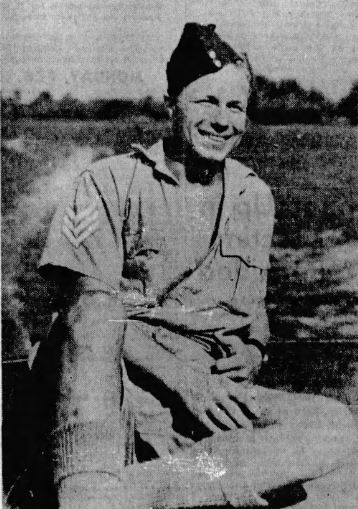 F/Sgt
John Raymond WOODCOCK R/87023 RCAF
F/Sgt
John Raymond WOODCOCK R/87023 RCAF
He was the son of Wells Henry and Elsie May Woodcock and he had
been born in Swindon, England in the summer of 1921. The
family moved to Canada in 1927.
He graduated from 5 Bombing and Gunnery School in November
1941. Newspaper reports of the graduation list a J R
Woodcock from Saskatoon as being a member of the
class. Earlier Saskatoon articles mention he
lived at 718 or 817 Melrose Avenue and was the son of W H
Woodcock. Later, the Star Phoenix newspaper printed in
Saskatoon, seems to carry a photo of him on 28 February 1944 and
perhaps also the day of his graduation as a gunner in 1941,
mentioning a Jack Woodcock of 314 Main street serving in West
Africa. He married a Delma Clarke in July 1945.
He was posted to the UK in December 1941, and returned to
Canada in August 1944 and left the services in September
1945. Conflict hit his family badly. His brother Ernest
Henry Woodcock, serving with the Royal Navy, Fleet Air Arm, was
killed in a November 1944 flying accident from HMS Seaborn, the
shore station at Dartmouth, Nova Scotia. Harvard FE620 of
the RCAF crashed killing Ernest and P/O J L J P Pelletier.
Then, another brother, Norman Woodcock was killed in action in
the Korean War in 1951.
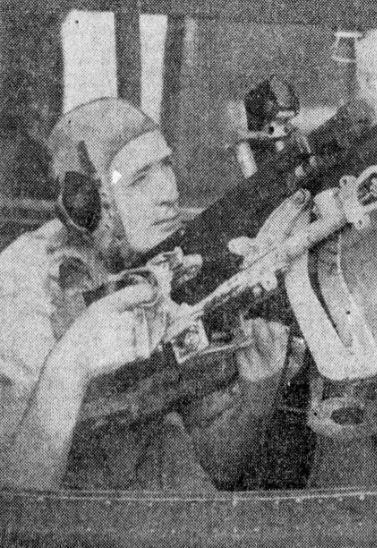 Sgt
William Edward BITZ R/58577 RCAF - During
his time with 270 Squadron he was commissioned as an officer
with number J18554.
Sgt
William Edward BITZ R/58577 RCAF - During
his time with 270 Squadron he was commissioned as an officer
with number J18554.
He and his brother, Frank J Bitz both served with the RCAF, with
Frank flying Mitchell bombers in North West Europe with 180
Squadron, Royal Air Force. William had joined the RCAF in
August 1940 and been posted to England in November of that
year.
Their local newspapers, The Vancouver Sun and The Province,
carried news of their exploits throughout the war.
The Province of 6 May 1942 reported:
WINS COMMISSION. Pilot Officer F. J.
Bitz, who recently received his wings at Dauphin, Man., has
returned east for further training after visiting his
mother, Mrs. N. Bitz, and sisters, at 2395 West Seventh.
Born in Saskatchewan, he was educated at St. Augustine's and
Kitsilano High schools, and prior to his enlistment, was
employed with Carter, Halls, Aldinger, Cn. Ltd. His
brother, William E. Bitz, is serving as a wireless
over-server with the R.C.A.F. in England.
The Vancouver Sun in September 1943 while reporting again on
Frank mentioned that William was at that time posted to West
Africa.
The 26 February 1944 edition of the The Vancouver Sun carried a
photo of William with the caption: Manning
a gun in one of the turrets of the Catalina flying boat in
which he flies out over the South Atlantic, is PO William
Bitz, 28, of 3329 West Third, Vancouver. He Joined the RCAF
in February, 1940, and has done most of his operational work
with the Coastal Command. He was one of the crew of a flying
boat which located the survivors of a torpedoed ship and
aided in their rescue. He is a veteran of the hazards of
tropical flying.
His return home was announced by The Province on 7 August 1944
with the following article: Air
Veteran Home After Congo Flying. FO. W. E. Bitz,
son of Mrs. A. Bitz, 3329 West Third, veteran of air
campaigns in Belgian Congo, Britain and North Africa, was
one of B. C. airmen who arrived in Vancouver Saturday from
overseas. FO. Bitz, who enlisted In the F.A.C.F. in August,
1940, was a former employee of the B. C. Plywods Ltd. He
attended St. Augustine's School and Kitsilano High School.
FO. E. A. Anderson. 3493 Norfolk, Burnaby, who had been
overseas for nearly three years, was also on the train. Both
officers will serve as instructors in ' Canada when their
furloughs are ended.
The Vancouver Sun carried the same story in this way:
"Thousands of flying hours In the
Belgian Congo, England and the African theatre of war were
piled up by FO. W. E. Bitz, 3329 West Third, who has been
with the RCAF since August, 1940. A former employee of B. C.
Plywoods, he attended St. Augustines' and Kltsilano High
School. He will instruct at Patricia Bay when his leave is
up. "We've Spent the last 24 hours listening to his
stories," Mrs. A. .Bltz, his mother, told The Vancouver Sun,
Sunday, "but the boys don't seem to like much in the
papers." Mrs. Bitz's other son, Fit.- Lieut. F. J. Bitz.
also a Kltsilano student, is now with the ' 2nd Tactical Air
Force."
William was mentioned again in December 1944 in The Province
newspaper, upon the return home of Frank from Europe, where
William is described as being based at Pat Bay as a Flying
Officer. Pat Bay was Patricia Bay, a RCAF base in
Victoria, British Columbia.
F/Sgt Alan BLACKWELL 1169378, an RAF airman, nothing else is known about him at this time.
F/Sgt Maurice HEWES 1489484 - The name of this airman
was difficult to confirm due to the poor quality of the
handwriting and typing in the Irish Army file. However, from the
270 Squadron ORB it becomes clear he was Maurice Hewes.
Maurice became estranged from his family after the war and thus
no wartime memories or photos seem to survive of him.
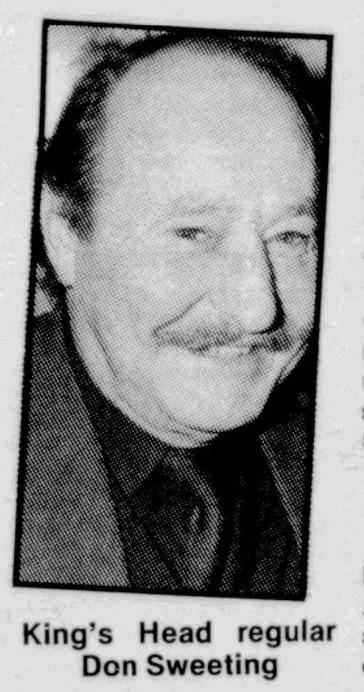 Cpl
Donald Vaughan SWEETING 568527 - With his rather distinct
surname Donald Sweeting is one English man on this aircraft that
can actually be traced at this time. D V Sweeting was
commissioned as an officer in the Royal Air Force, as opposed to
the RAF Volunteer Reserve, in late 1943 with new serial number
53268. In 1953 he was appointed to the rank of Flying Officer in
the Reserve of Air Force Officers (RAFO). This appointment was
relinquished in 1955. This appointment in Class CC of the RAFO
is consistent with reserve officers who flew with civilian
airlines and Donald's relatives understand that he continued to
fly the Atlantic after the war, probably with BOAC. Donald never
married and died in 1989 in Sussex
Cpl
Donald Vaughan SWEETING 568527 - With his rather distinct
surname Donald Sweeting is one English man on this aircraft that
can actually be traced at this time. D V Sweeting was
commissioned as an officer in the Royal Air Force, as opposed to
the RAF Volunteer Reserve, in late 1943 with new serial number
53268. In 1953 he was appointed to the rank of Flying Officer in
the Reserve of Air Force Officers (RAFO). This appointment was
relinquished in 1955. This appointment in Class CC of the RAFO
is consistent with reserve officers who flew with civilian
airlines and Donald's relatives understand that he continued to
fly the Atlantic after the war, probably with BOAC. Donald never
married and died in 1989 in Sussex
The photo of Donald came from a local newspaper in Shepperton,
Sussex where he was a patron of the King's Head pub in the town.
If anyone reading this knows anything about any of the airmen above, I would love to hear from them.
The aircraft was a Consolidated Catalina flying boat and is at least more easily traced than its crew. The Irish Army report records the aircraft having the marks FP202. This aircraft is recorded as being assigned to 302 Ferry Training Unit (FTU) which was setting up at RAF Stranraer in Scotland during the winter of 1942. Its function was to train crews for the arduous tasks for flying aircraft from bases in the UK to places such as Gibralter, it is not clear yet to where this crew were posted. The aircraft itself was posted to 212 Squadron which was formed up in India at about the same time. The Squadron Operation Book records that Catalina FP202 left the UK on 21 January 1943 and arrived at 212 Squadrons base at Karachi in India on February 1st. The crew that flew her out included the Squadron Commanding officer, Sqn Ldr A F Johnson DFC. It was sent on a detachment to Masirah off the coast of Oman.
Consolidated Catalina, JX330, 1944
On the afternoon of March 9th, 1944 a Catalina flying boat landed on the Shannon river near the flying boat base at Foynes. Foynes was a well known flying boat base in neutral Ireland during the war, it was a terminus of the route from neutral Portugal so there was much traffic through it from there, the UK and America. The base was run by British Overseas Airways Corporation (BOAC), the wartime airline in the UK.
The crew of the Catalina were seen by the staff at the base and given assistance by them. They were towed or taxied themselves up to the actual base and moored there. Captain Adams elected to stay the night at the Flying Boat base as they had just flown a tiring 26 hours after leaving Bermuda. The aircraft would have been flown on the southern Atlantic route, it being still rather early in the year. Officers from the Irish Army met them at the base and took their details which formed the basis for learning more about each of the six crew men on board. Many of the names were confirmed from the Ferry Command records held by the Canadian Directorate of History and Heritage.
Captain Adams reported they had been flying over 26 hours and they were a little lost and getting tired. They took full advantage of the hospitality shown them at Foynes and some members of the crew had to retire to bed rather worse for ware. They were allowed to depart the next day after being refueled with 300 gallons from stocks at the base. Their intended destination was Largs, on the Clyde in Scotland. Had they continued on the previous day they might well have met with a mishap on the mountains of Ireland or Scotland or maybe had to ditch at sea.
The crew were four civilian RAF Transport Command staff, as well as a serving member of the Royal Air Force and one officer from the Royal Australian Air Force (RAAF). All six survived the war.
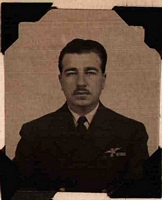 |
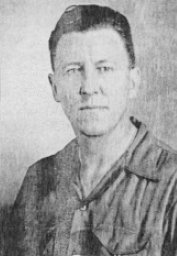 |
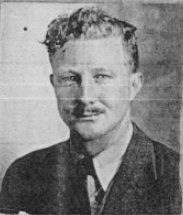 |
|
Capt. Ralph Elishea ADAMS (Civilian Pilot, Captain) |
Clyde Cecil FOREMAN (Civilian Pilot, Co-Pilot)) |
P/O Charles William MCGREGOR-SHAW 404612 RAAF, Navigator |
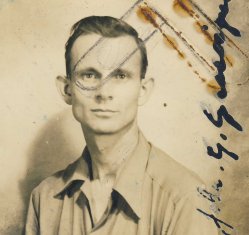 |
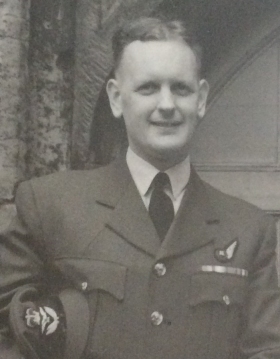 |
 |
|
John Gilderdale GASCOIGNE (Civilian, Radio Operator) |
Sgt John Vernon LOCKE 1582748 RAF, Radio Operator |
Charles Oakley J WOODARD (US Civilian, Flight Engineer) |
Ralph Elisha ADAMS was a Texas born pre war airline pilot. He was indeed one of the very first pilots employed by Canadian Pacific Railway when the Ferrying Operation was begun and he flew Hudson T9418 on the very first ferry operation of the war in November 1940. He went on then to fly all throughout the 1941 to 1944 period, delivering aircraft to destinations mainly in Europe but also including trips to India and Russia. He was at times a flight crew member on the vital Return Ferry Service which delivered crew members from England back to Canada after their deliveries. On other occasions he can be found arriving in New York on transatlantic liners. His last deliveries on his Ferry Command card are in December 1944 but he can be found traveling to New York again during 1945. In 1943, he obtained a pilots license from the Royal Aero Club. He was mentioned in many American and world wide newspapers in the summer of 1942 when he flew the Atlantic five times in nine days, breaking all previous records. This endeavor was carried out in Liberator AL514 of the Return Ferry Service in June of that year. The story was recorded in the newspapers as shown:
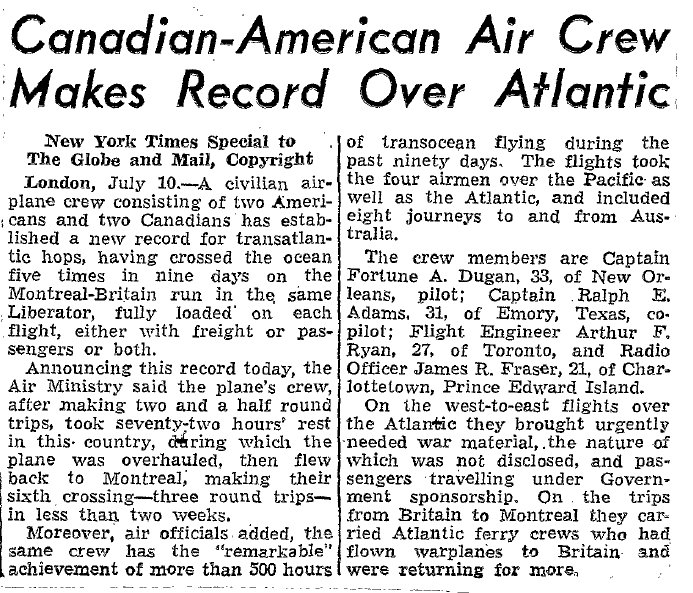
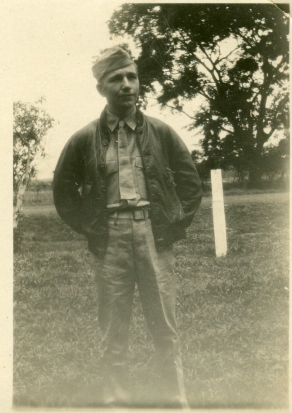
The above article was found in the Globe and Mail newspaper,
dated 11th July 1942.
Ralph's daughter explained that her father joined the US Marines
when he was 17 and was sent to Nicaragua where he learned
mechanics and eventually to fly. The photo at left shows him
during this time. After his stint in the Marines he came back to
east Texas and from there took various courses in airplane
engines, and flying. He always maintained that a pilot needed to
understand the engine as well as how to fly. Ralph later flew
with the CIA organization, Air America in South East Asia, being
involved in the delivery and training with deHaviland Canada
L-20 Beavers in early 1962. Ralph passed away in Orange County,
California aged 74 in November 1985.
Clyde C FOREMAN was another pre-war commercial aviator,
working for a time with Air Activities inc in Houstan,
Texas. His name is found in aviation journals in 1937
reporting on the aviation news from Houstan, Texas.
He hailed from Oklahoma, the son of Essie and James
Foreman. Born in Oklahoma in 1911, he had his home in
Texas, with his wife Earline Foreman, at the time of registering
for the draft in October 1940. At that time he was working
as a stenographer with an oil refining company. In the earlier
1930 census he is found as a twenty year old Motorman on a
freighter named the William S Penn.
In 1941, he had been among the pilots sailing to the United
Kingdom aboard the SS Nerissa when she was torpedoed. Upon his
arrival he was signed up with the Air Transport Auxiliary (ATA)
starting in April 1941 and he served through to March 1943 with
them. A letter from the ATA at that time testified to his
excellent service and recorded his having flown 584.85 hours on
38 different types of aircraft. His Ferry Command service
was varied much like Adams' and Gascoigne's and he found himself
at the controls of various aircraft in various far flung lands
including the powerful Mosquito fighter bomber. His photo comes
from his Ferry Command card. Ralph Adam's family explained that
Ralph and Clyde remained friends after the war.
He doesn't appear to to have remained in aviation post war as
he is found in various records with a variety of employments,
including painter and stock broker. In the latter role, he and
his wife and two sons lived in Florida for most of the 1950's
and 1960's. His two sons became marine aviators.
Clyde passed away in 1974 in Texas.
Charles W McGregor Shaw was an officer of the Royal
Australian Air Force (RAAF) whose wartime career was spent with
Ferry Command. Charles came from Sidney in New South Wales. Born
in 1914, he was the son of George and Ellen McGregor Shaw.
Enlisting in 1940, he sailed for Canada in March 1941 where he
completed his flight training with various training
establishments including, 1 SFTS Camp Borden; 5 AOS, Winnipeg; 7
BGS at Paulson, Manitoba and finally 1 Air Navigation School at
Rivers, he was assigned to Ferry Command in the summer of 1942
and served with on Ferry operations until late 1944.
He married in July 1943 to a Ruth Fleming in Montreal.
Many of his deliveries were to African destinations across the
long south Atlantic route.

Charles was posted home to Australia at the wars end and his
wife, Ruth and their twin sons travelled to Australia in January
1946, their trip being covered by many Canadian newspapers.
Charles died in 1996.
John G Gascoigne was a long term member of Ferry Command having flown for the first time with them as early as August 1941. Indeed this first ferry ended with the aircraft crashed at Gander, Newfoundland. He went on to fly throughout the war as a Radio Operator, having up to 29 deliveries to his credit and having travelled to places as far afield as India and South Africa. Being a radio operator, he was able to fly on any number of aircraft, and his list was impressive, including Liberators, Hudsons, Mariners, Fortress', Mitchells and Catalinas. His daughter Lynn and her husband Graham were kind enough to provide a number of scanned items from this items he left. His daughter said of him: "He was born in Worcester England in 1907 , the middle of three children to Frederick Octavius Gascoigne and Agnes Mary Philpot. He emigrated to Canada when he was 17 as his intention was to farm. He worked on many farms over the depression, often just for room and board, all across Canada. In the mid 1930’s he took a radio course in Chicago and joined Canadian Pacific where he was a radio operator on the Great Lakes until the war started. He married my mother, Mary, in 1942 in Montreal and I was born in 1945. After the war he joined the Department of Transport where he continued to work as a radio operator until technology took over around the time he was due for retirement. He died in 1978 of cancer after a valiant struggle."
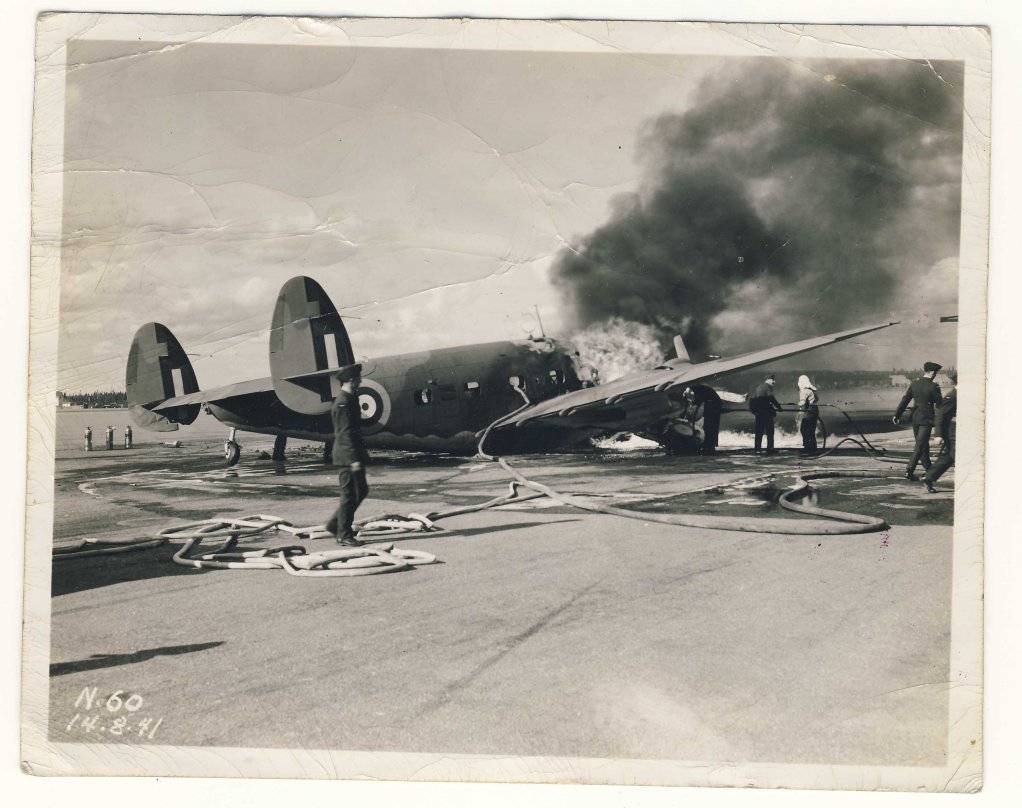
A photograph of a burning Hudson bomber from among John's things, it is thought that this is Hudson V9181, the first ferry aircraft listed on his Ferry Command card. It is recorded that this aircraft crashed on take off at Gandar on 14 August 1941, the date on the photo.
John Vernon Locke was a serving member of the Royal Air
Force. John hailed from Matlock in Derbyshire having been born
to x and x Locke. He began his service with Fery Command
as a Sergeant, Wireless Air Gunner (WAG) and it was his training
as a radio Operator that seen him flying on JX330. He flew for
Ferry Command for one year, from March 1944 to March 1945.
During this time he was promoted to Officer rank. He continued
to serve in the RAF after the war and his retirement was
published in the London Gazette in 1969. His post war
service seen him serve in the RAF's Avro Vulcan force.
He was born in Matlock in 1924 and passed away only three years after his retirement in 1972.
 Charles
Oakley Woodard was a 30 year old pilot and came from
Illinois. He was born to Charles and June Woodard in
December 1913 in Marion, Illinois. His draft registration in
1940 is found in New York City, at a Lexington Hotel.
Charles
Oakley Woodard was a 30 year old pilot and came from
Illinois. He was born to Charles and June Woodard in
December 1913 in Marion, Illinois. His draft registration in
1940 is found in New York City, at a Lexington Hotel.
The Evansville Courier and Press printed the following article
about him in December 1941:
MARION FERRY FLIER TO ENTER U. S. NAVY
MARION, Ill. Dec. 14 (Spe
Oakley Woodard. son of Mr. and Mrs. Charles Woodard, of
Marion, will leave the Canadian ferry command soon to return
to service in the U. S. navy, according to word received
here.
The Marion flier, who has just returned to Montreal
after ferrying American built planes to Britain, told his
parents by telephone that he is planning a short visit here
before enlisting. He has completed six years in the navy,
where he received pilot's training. 13 months flying for an
oil company in South America and four years with an American
air transport company.
No wartime card exists for him in the DHH but he is found
traveling through New York on at least two occasions with other
Ferry personnel during 1944.
The Marion Weekly Leader on 02 March 1944, reported on the birth of his first daughter in Montreal. he is described as: The father, who has been a member of the Royal Air Force Ferry Command for more than two years, had just returned from a secret mission, and telephoned his parents Monday of the arrival of his daughter.
His ferry flight records indicate he served as a Flight
Engineer during his time with the Ferry organisation and
beginning with one flight in October 1941 on a Liberator,
thereafter on almost one aircraft per month to the UK, India or
Africa. He resigned from his job in December 1944.
After the war, he can be found as the co-pilot to the famous
William 'Bill' Vanderkloot flying with the Johns Manville
Corporation in business aircraft, including Beech D18, NC44643
in the years 1946 to 1948. He used his middle name, Oakley
in some cases.
He passed away in Arizona in 1995. His obituary mentioned his being a Navy veteran.
Having survived its short stay in Ireland, Catalina JX330 was
delivered to the RAF and entered service on patrol missions.
The Squadron ORB of 205 Squadron on Dec 6th 1944 records that an
air test was carried out on Catalina JX330 after a major
maintenance inspection.
it is recorded also in the ORB for 191 Squadron, flying a number
of missions during May 1945 from Korangi Creek in India.
Catalina JX422, Foynes, Limerick
On the 5th September 1944 one of the more mundane of the wartime aircraft landings occurred in the Shannon Estuary near County Limerick. However, what now appears as mundane must have been quite a worry for the crew of five airmen who found themselves putting down a large Catalina flying boat early that Autumn morning.
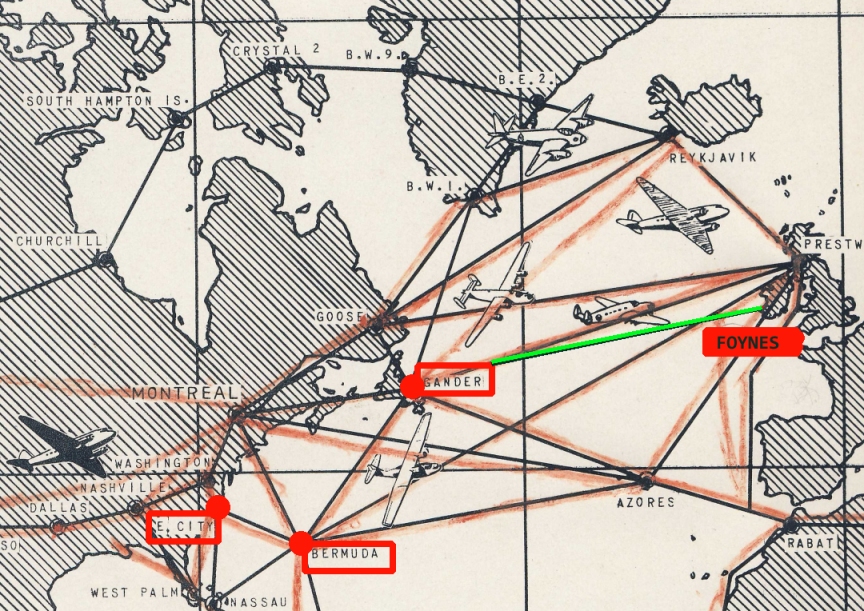
The crew taxied the aircraft from the area they landed to the Flying Boat base at Foynes. There they made themselves known to the British Overseas Airways Corporation staff.
The local Gardai in Foynes submitted the following report on
the 6th of September:
"In confirmation of my telephone call to your office on the
5/9/44 in connection with above matter, I beg to report that
at 1 p.m. on the 5/9/44, an R.A.F. twin engined Catalina
flying boat landed in Foynes Harbour. The aircraft was taken
under control by the Shannon Airport Control Launch and
conducted to a mooring in the harbour, after which she was
boarded by Captain Hewitt, Security Army Officer at Foynes.
It was ascertained that the aircraft which carried a crew of
five was a Catalina twin engined machine, registration Number
J.X.422, carrying four mounted guns, which were sealed as
received from the manufacturers, had no ammunition for same,
and carried no small arms, and was in the course of delivery
from Canada to United Kingdom by R.A.F. Transport Command.
Information to hand is that the aircraft made an unsuccessful
attempt to land in two Ports in the United Kingdom, and at
Lough Erne in Northern Ireland, but was unable to do so owing
to unfavorable weather conditions prevailing in the places
stated.
After receiving instructions from his Hd. Qrs., Captain Hewitt
had the machine placed under Military guard, and had the crew
taken off, and accommodated at the British Airways Camp
outside Foynes, where they remained until the morning of the
6th instant, when they left, boarded the aircraft at 11 a.m.
and left Foynes Harbour for Northern Ireland, to complete
their journey. The reason for going to northern Ireland
was stated to be due to complete their journey. The reason for
the going to Northern Ireland was stated to be due to bad
weather conditions prevailing in the U.K. their final
destination. It was stated by the crew that the aircraft was
eighteen hours in the air in the course of her flight between
Canada and the United Kingdom, before landing in Foynes
Harbour, and this was borne out by the fatigued looking
condition of the crew when they did come ashore. The machine
did not present the appearance of being in combat, and the
paper sealing was plainly visible on the guns of the
aircraft."
The report went on to detail the names and addresses of the crew and noted that only Thomas A Baxter was a serving RAF officer and the others were in their words, 'more or less civilian employees of the Manufacturing firm attached to Transport Ferry Command'.
The Army security officer Hewitt mentioned above submitted a
further report the same day and stated therein: "As soon as possible I boarded plane, and
learned from the pilot, Capt. Lancing, that he had left
Gander Lake some 18 hours previously, had twice attempted to
land at Lough Erne, but was prevented by adverse conditions
and as he was running short of petrol, made for Foynes.
Owing to the tired condition of crew, he wished to stay the
night of possible, before proceeding to Prestwick. At this
point Lt. M. Graham of the Mt. Trenchard Garrison arrived in
another launch, and said that he had orders that "only the
badly wounded were to be allowed ashore". I told Captain
Lancing there would be a delay, and proceeded ashore. Cmdt.
J. Lane had arrived, and was contacted. He repeated the
order that no one was to be allowed to land. It also
appeared that he wished to take the crew under escort to
Mount Trenchard. I particularly stressed the fact that he
was not dealing with ordinary RAF ratings, one member of the
crew only, was a regular RAF; that the plane was in charge
of a pilot of the Transport Command on a delivery flight;
that although there were 4 machine guns aboard, they were
all sealed as received from the manufacturers and there was
no ammunition of any kind on board: I also repeated the
request to be allowed to bring the crew ashore as they had
been on duty for 18 consecutive hours, were very tired, and
were getting sick from the motion of the aircraft at the
moorings in rough water. This was refused, as Cdt. Lane said
he must get into touch with Collins Barracks Cork first.
After contacting Cork, Cdt. Lane told me he was entrusting
the crew to my care. Crew were therefore brought ashore
about 45 minutes after mooring. A Corporal O'Sullican of the
15th. Batt. was placed aboard by the Cdt., and as there was
a good deal of loose equipment about, I requested Capt.
Lancing to leave a member of his crew aboard. This crew
member was later replaced by a BOAC watchman in agreement
with the Captain, as no member of the crew was fit to be on
watch. BOAC had been asked by their London officer to render
every assistance possible after obtaining the approval of
the State authorities. Crew was taken to Bolands meadow
where they were provided with beds and given food. They
slept there on the night of 5/6 Sept., and as weather
conditions had improved today, left at 11.24 by the the
Lough Erne Corridor. C.S.O. of the Air Corps authorised
refueling, and 400 gallons of 100 octane spirit was supplied
by the Shell Coy.
It is understood that instructions have already been issued
to those concerned, that RAF Transport Command, or passenger
carrying planes alighting in this area, will be dealt with
by the Foynes Airport Security Officer. May it be
respectfully suggested that these orders be repeated and so
obviate delay and confusion in future case of a like nature."
The crew of the aircraft gave their names to the Irish military and from this source, their names have been confirmed from wartime records to be the following five men:
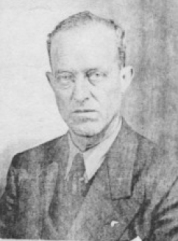 Wayne Frederick LANSING
Wayne Frederick LANSING |
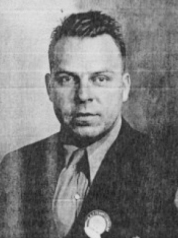 Charles Alfred CHILDS
Charles Alfred CHILDS |
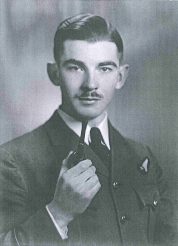 F/O John Henry HORLER 153748 RAFVR
F/O John Henry HORLER 153748 RAFVR |
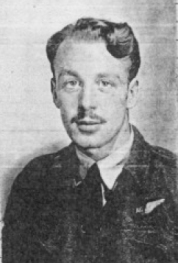 F/Sgt Thomas Anthony BAXTER 633692
F/Sgt Thomas Anthony BAXTER 633692 |
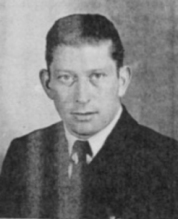 Marcel Mendel MORRIS
Marcel Mendel MORRIS |
Wayne Frederick LANSING was a 45 American pilot at the time of his short stay at Foynes. Wayne was born in Indiana to Louise and Lee Frederick Lansing. His year of birth on records varies from 1894 to 1898! First World War records show that he had served as a Private in the 108th Supply Train, a part of the 33rd Infantry Division.
He was in 1927 the chief instructor of and vice president of
Decatur Airways Corp., a flying training school set up near
Decatur and Clinton, Illinois. The Decatur Evening Herald
claimed that he was a veteran of the A.E.F., the First World
War, American Expeditionary Force, and it was during his time in
France that he met Capt. Eddie Rickenbacker and other famous
members of the American Flying service. His interest
in flying stemmed from this time.
In 1928 he was flying as a commercial pilot in Iowa, piloting a
Ryan Brougham during a June 1928 aviation tour of cities in
Iowa. He became a pilot with Braniff in 1929 and was married, a
second time, in 1930 in Mexico, newspaper reports of the time
mention that he was then a Pan American pilot.
By 1940, he was living in Santa Monica, California, with his
third wife and was working as a pilot. He featured in an
edition of Flying and Popular Aviation in October 1940 in their
"I learned about flying from that!" series.
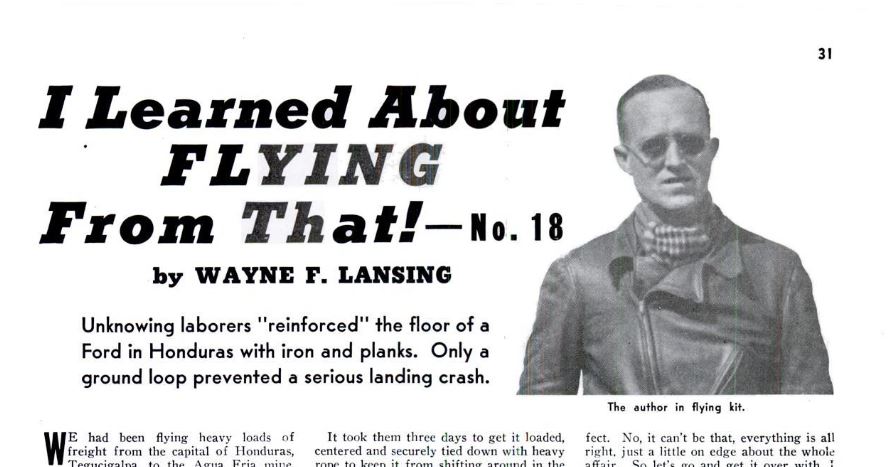
He is mentioned in the 1942 Who’s Who in Aviation as being pilot
with Pan American Ferries. He appears on a number of manifests
of Pan Am flights returning from Africa and South America during
1942. His Ferry Command records indicates he began flying with
that service in May 1943 and flew numerous aircraft to Europe
and Africa.
Wayne married again in 1948 in California, both he and his new
bride being divorcees. She had been present with him in
January 1947 with two other passengers when an aircraft he owned
turned over during a forced landing in North Hollywood.
This was one of many marriages Wayne appears to have had.
He passed away in 1963 in California where he had made his home.
Charles A CHILDS was born in Michigan in 1915 to Minnie
and XXX Childs. By 1940 he was emplyed by Central Air
Service Inc in Grand Rapids, however in the census return of
that year his occupation is listed as a restaraunt chef.
He was the co pilot on Catalina JX442 during it's journey to
Europe. He flew extensively with 45 Group from his joining in
1943 through to the end of 1944. Charles and Wayne Lansing
both arrived back in New York on the 17th September on the Queen
Elizabeth. During 1945 he seems to have flown as a regular
First officer (Co-pilot) of Transport Command aircraft in Canada
and America.
In 1966, he featured in an advertisement of Wilcox Transponders
in American Aviation publications, being the Chief pilot with
Gerber Baby foods.
Charles passed away in 1992 in Michigan. Buried with his wife
Verna, his grave stone carries an engraved DC-3 image.
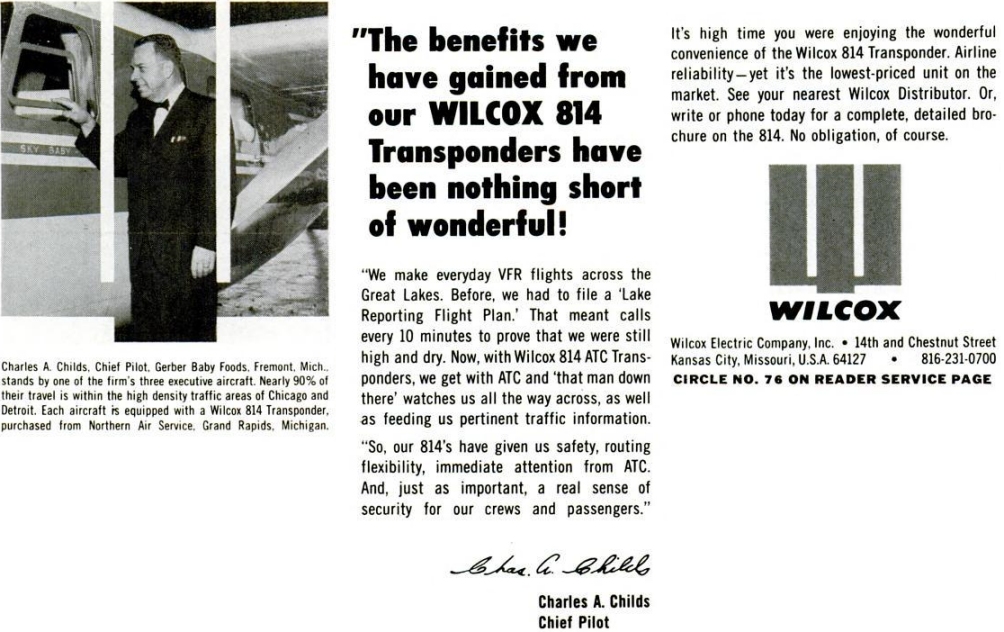
The name John H Harley was recorded by the Irish Army at the time of the incident at Foynes. He was aged 21 and was the navigator on the aircraft. It is implied in the Irish Army report that he was a civilian and was from Reading in England. This airman was confirmed in 2013 as being John Henry HORLER from Reading and a letter to an address near in Reading was replied to by Mr Horler who supplied a copy of a page from his wartime log book confirming that he was on Catalina JX442. He later served with the RAF’s 231 Squadron on trans-pacific transport flights during 1945 and his name appears on many flight manifests for that year.
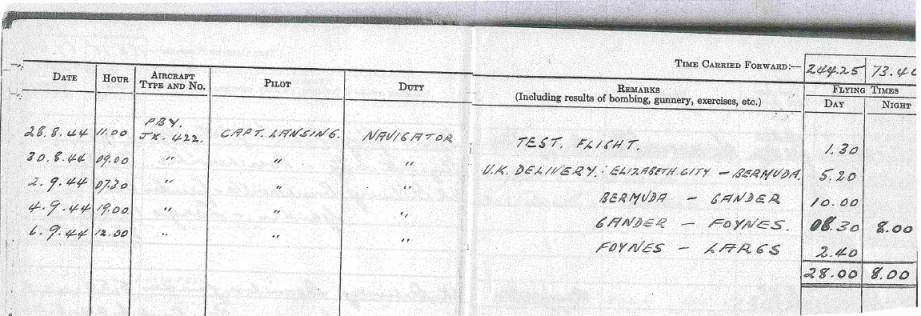
Thomas Anthony Baxter was a young Flight engineer from Atherton near Manchester in England. He was a serving member of the RAF and held the rank of Flight Sergeant. He had flown with Ferry Command and 45 Group as early as August 1942 when he delivered three Catalina’s overseas. The rest of his wartime deliveries were on Liberators with some Catalina’s interspersed. He also helped deliver two Canadian built Lancaster’s to the United Kingdom, KB711 and KB755, during 1944. His name can be found on the manifests of four aircraft arriving at New York during May, June and July 1944. He was returning to North America having been on ferry duties. He traveled to India during 1944 also. Thomas Baxter passed away in Taunton District in April 2006.
The radio operator on this Catalina was Marcel Morris,
a 33 year old civilian from London, the son of Maurice and
Celine Morris. His name appears on British Postal Service
Appointment books in May 1940 as being a certified Wireless
Operator, a common occupation for those who later flew as ferry
radio operators. The 1939 register however has him as a
manager of a Hat and Cap factory. His Ferry Command
service card shows him operating from September 1942 to December
1944.
Marcel was married in 1947 to Marguerite Ellenson (nee
Kholodenko). He passed away in London in September 1970 aged 59.
The aircraft itself was a version of the famous Consolidated Catalina Flying boat. This aircraft was not built be Consolidated but by the Boeing of Canada company at their Sea Island facility at Vancouver. This was one of a batch of Boeing PB2B-1 Catalina's delivered to the US Navy and the Royal Air Force and Royal New Zealand Air Force. These aircraft were license built versions of Consolidated's own PBY-5 model and were non amphibious airframes.
